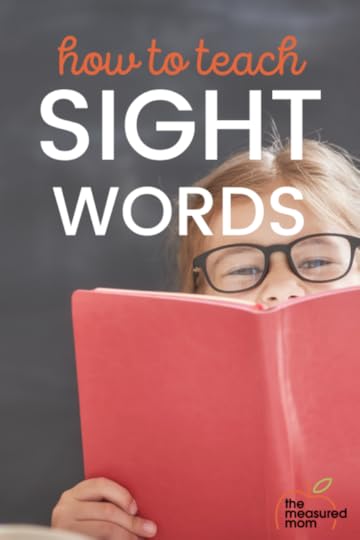How to teach sight words
I receive many emails from teachers and parents asking me how to teach sight words.
Are you here to learn how to teach high frequency words? You’re in the right place!
 What are sight words?
What are sight words?Traditionally, when teachers say “sight words,” they are referring to high frequency words that children should know by sight.
We often define sight words as words that kids can’t sound out – words like the, for example.
However, reading researchers have a different definition of sight words.
A sight word is a word that is instantly and effortlessly recalled from memory, regardless of whether it is phonically regular or irregular. A sight-word vocabulary refers to the pool of words a student can effortlessly recognize.
David A. Kilpatrick, PhD
So should we get lists of sight words and get our students to memorize them using flash cards?
Not so fast.
This doesn’t fit with how the brain learns to read.
We are not trying to get students to cram pictures of words in their brains, because there’s a limit to how many words any of us can remember by sight.
How does the brain learn “sight words”?Researchers have discovered that strong readers do not call upon thousands of pictures of words in their brains. Instead, they (very, very quickly) connect the letters to the sounds in each word. They do this so quickly and effortlessly that it takes a tiny fraction of a second to identify each word.
How?
How do we move from sounding out words letter by letter, to recognizing thousands and thousands of words instantly?
It’s through a mental process called orthographic mapping.Say what?
Stick with me … I promise it’s not as complicated as it sounds.
Orthographic mapping is the process we use to store printed words in long-term memory.
David A. Kilpatrick, PhD
In order for us to read words and then store them for future retrieval, we must be able to match the phonemes (sounds) to the graphemes (letters).
Does that sound familiar to you?
It’s phonemic awareness and phonics.
We need to teach children to identify individual sounds in words and then connect those sounds to letters. We teach them to sound out words, even sight words.
What about sight words that aren’t regular, like the?We call attention to the parts of the word that are phonetic (and there���s usually at least 1-2 of them). Then we teach learners to learn the tricky parts by heart.
So what does this tell us about the big sight word lists … like Dolch and Fry?I don’t think it’s wrong to teach kids to read words using those lists as a reference, but we need to approach it a different way.
We shouldn’t be sending home lists of 50 “sight words” for our kindergartners to master.
Instead, we should integrate those words into phonics lessons as often as possible.
For example, the Dolch primer list includes words like these:
on, at, did, that, ran
Each of those words is perfectly decodable, and rather than teach them by sight, we should teach kids to read them using their phonics knowledge.
When we give then opportunities to sound out the words when reading them, we are providing an environment for orthographic mapping to take place.
Is there ever room for teaching kids to memorize high frequency words?Yes, but only a small amount (think 10-15 words), and only to make our students’ early reading material readable.
For example, a good decodable book (that actually sounds like a story) will need words like the. You will need to teach early readers to recognize the word the. And yet you can STILL call attention to the “th,” which is not irregular at all.
How to introduce sight wordsAssuming your learner has phonemic awareness and letter-sound knowledge, you’re ready to begin. (Not sure about the phonemic awareness? Give this free assessment.)Name the new word, and have your learner repeat it.Name the individual phonemes (sounds) in the word. For example, in the word is, there are two phonemes: /i/ and /z/.Spell the sounds. Call attention to any unexpected spelling. In is, we spell /i/ with i and /z/ with s.If possible, have your learner read related words. Has and his are great words to read alongside is because they are short vowel words with an s that represents the the /z/ sound.Have your learner read connected text. Connected text can be decodable sentences or books.More resources for learning about high frequency wordsFree lessons and decodable books for teaching high frequency wordsA new model for teaching high frequency words – Reading RocketsHeart Word Magic – Really Great ReadingTeaching Every Reader (online course)Essentials of Assessing Preventing, and Overcoming Reading Difficulties, by David A. KilpatrickThe post How to teach sight words appeared first on The Measured Mom.
Anna Geiger's Blog
- Anna Geiger's profile
- 1 follower



